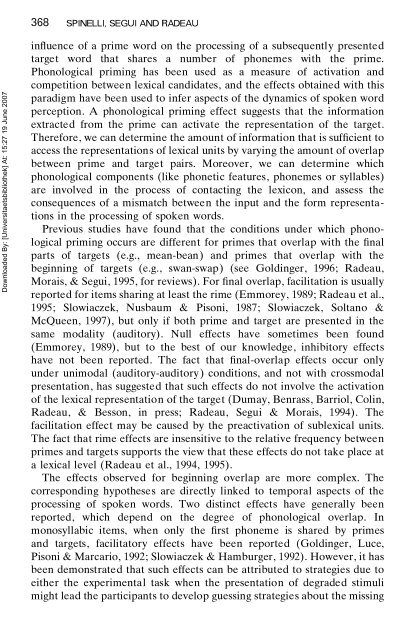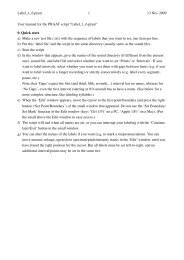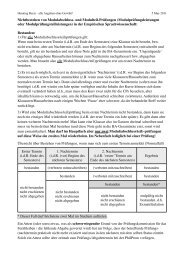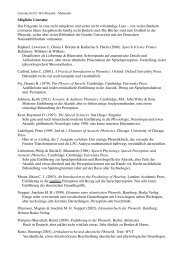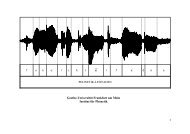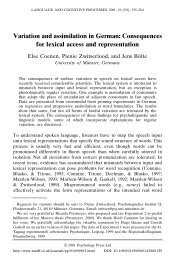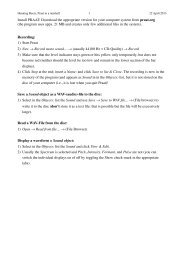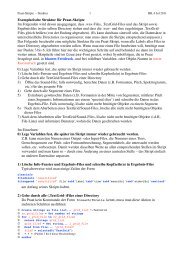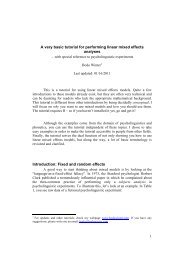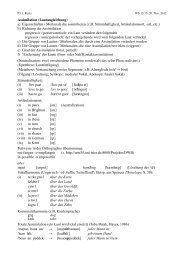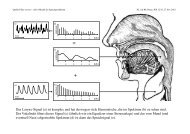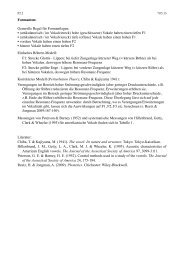Language and Cognitive Processes - Institut für Phonetik
Language and Cognitive Processes - Institut für Phonetik
Language and Cognitive Processes - Institut für Phonetik
Create successful ePaper yourself
Turn your PDF publications into a flip-book with our unique Google optimized e-Paper software.
Downloaded By: [Universitaetsbibliothek] At: 15:27 19 June 2007<br />
368 SPINELLI, SEGUI AND RADEAU<br />
inuence of a prime word on the processing of a subsequently presented<br />
target word that shares a number of phonemes with the prime.<br />
Phonological priming has been used as a measure of activation <strong>and</strong><br />
competition between lexical c<strong>and</strong>idates, <strong>and</strong> the effects obtained with this<br />
paradigm have been used to infer aspects of the dynamics of spoken word<br />
perception. A phonological priming effect suggests that the information<br />
extracted from the prime can activate the representation of the target.<br />
Therefore, we can determine the amount of information that is sufcient to<br />
access the representations of lexical units by varying the amount of overlap<br />
between prime <strong>and</strong> target pairs. Moreover, we can determine which<br />
phonological components (like phonetic features, phonemes or syllables)<br />
are involved in the process of contacting the lexicon, <strong>and</strong> assess the<br />
consequences of a mismatch between the input <strong>and</strong> the form representations<br />
in the processing of spoken words.<br />
Previous studies have found that the conditions under which phonological<br />
priming occurs are different for primes that overlap with the nal<br />
parts of targets (e.g., mean-bean) <strong>and</strong> primes that overlap with the<br />
beginning of targets (e.g., swan-swap) (see Goldinger, 1996; Radeau,<br />
Morais, & Segui, 1995, for reviews). For nal overlap, facilitation is usually<br />
reported for items sharing at least the rime (Emmorey, 1989; Radeau et al.,<br />
1995; Slowiaczek, Nusbaum & Pisoni, 1987; Slowiaczek, Soltano &<br />
McQueen, 1997), but only if both prime <strong>and</strong> target are presented in the<br />
same modality (auditory). Null effects have sometimes been found<br />
(Emmorey, 1989), but to the best of our knowledge, inhibitory effects<br />
have not been reported. The fact that nal-overlap effects occur only<br />
under unimodal (auditory-auditory) conditions, <strong>and</strong> not with crossmodal<br />
presentation, has suggested that such effects do not involve the activation<br />
of the lexical representation of the target (Dumay, Benrass, Barriol, Colin,<br />
Radeau, & Besson, in press; Radeau, Segui & Morais, 1994). The<br />
facilitation effect may be caused by the preactivation of sublexical units.<br />
The fact that rime effects are insensitive to the relative frequency between<br />
primes <strong>and</strong> targets supports the view that these effects do not take place at<br />
a lexical level (Radeau et al., 1994, 1995).<br />
The effects observed for beginning overlap are more complex. The<br />
corresponding hypotheses are directly linked to temporal aspects of the<br />
processing of spoken words. Two distinct effects have generally been<br />
reported, which depend on the degree of phonological overlap. In<br />
monosyllabic items, when only the rst phoneme is shared by primes<br />
<strong>and</strong> targets, facilitatory effects have been reported (Goldinger, Luce,<br />
Pisoni & Marcario, 1992; Slowiaczek & Hamburger, 1992). However, it has<br />
been demonstrated that such effects can be attributed to strategies due to<br />
either the experimental task when the presentation of degraded stimuli<br />
might lead the participants to develop guessing strategies about the missing


